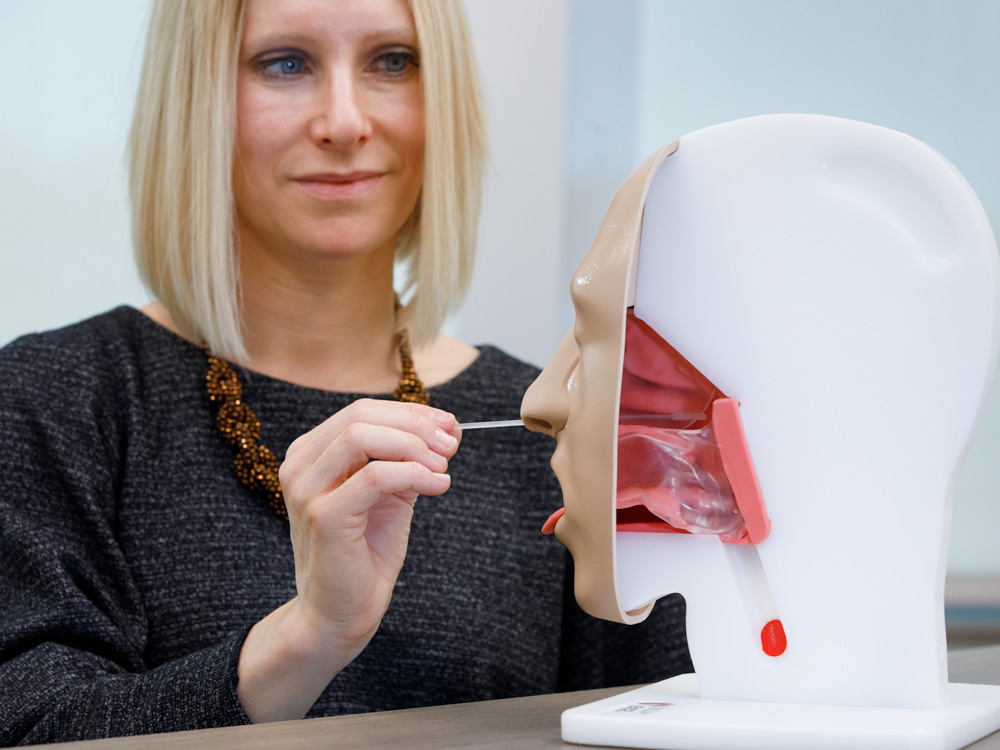up next Christie Barnes
Christie Barnes
iEXCEL and Medical Training Models
Developing a Training Model to Aid Accurate COVID-19 Testing
By Jackie Ostrowicki
February 2021
Millions of frontline workers across the world are performing nasal swabs to detect COVID-19. But, swabbing can produce false negative results when not done correctly—and can also injure patients with certain nasal conditions. A simple procedure has many chances for error.
Now, UNMC's iEXCEL team—in collaboration with campus health professionals—has created an advanced training model to help improve the skills of health workers performing these swabs. Medical training models help both students and professionals understand the proper alignment, techniques and movement when performing procedures.

Practicing Swabbing in a Risk-Free Environment
Using simulators in skills training not only improves technique, but does so in an environment where patients—and outcomes—are not at risk. It also allows health professionals to train safely and judgement-free. Trainees can practice on the anatomically correct manikin, which includes a color-coded indicator that provides feedback on whether they are performing the procedure properly.
“The keys to a proper nasopharyngeal swab has to do with the trajectory of the swab—the direction in which you are inserting it, as well as the depth,” said Christie Barnes, an assistant professor and rhinologist in the UNMC Department of Otolaryngology-Head and Neck Surgery. “The manikin has key landmarks that help make the proper trajectory clear.”
Barnes was part of a team that created the nasal swab model, which included other UNMC faculty members, iEXCEL team members, Nebraska Medicine and UNeMed. As they saw the trajectory of swabs being performed on TV news and heard reports from other health professionals on swabbing, they knew there was an opportunity for education.
"When we were faced with this pandemic, we realized that millions of frontline workers were having to learn a procedure that they had never done before or were not as familiar with.”
–Dr. Christie Barnes
Blending Artistry and Technology
Advanced training simulators incorporate elements of design, visual effects and digital video. In addition to the guidance and input of surgeons, physicians and teaching hospitals, many medical model companies also work with sculptors, fabricators, engineers and model makers.
The Chamberlain Group, who created UNMC’s anatomically accurate model to mimic tissues and structures of the oral and nasal cavities, is familiar with both technology and artistry. Early in their careers, founders Lisa and Eric Chamberlain worked in the visual effects industry on such feature films as "Superman," "Predator," "Eraser" and "The Matrix”. The group has been designing, developing and manufacturing anatomical models for clinical training for more than two decades.
This kind of simulation and visualization won’t just benefit frontline workers learning swabbing techniques. iEXCEL, the visionary program at UNMC that helped develop this model, emphasizes experiential learning. From augmented and virtual reality to lifelike patient models, technology like this will reshape the way in which health care education is delivered.
Discover our Podcast Series
The “Leading Nebraska” podcast shares the stories of the researchers, students, teachers and others across the University of Nebraska's four campuses who are making an impact. From teachers and doctors to engineers and ag experts, these Nebraska leaders are touching lives and making a difference.
Sorry, no stories match your filters.
Please adjust your filters above to view more stories.
Find Your Nebraska State Senator
Get started by entering your address below. Next, you'll receive information on who your senator is—and how to reach him or her.
Making a call only takes a few minutes and sends a strong message to your state senator. Your senator may not be able to take the call, but you can speak to the legislative aide who works for the senator. They will log your call, take a message and pass it on. Keep your conversation brief, and be sure to cover these essential points:
- Introduce yourself as a constituent in their district and provide your name.
- Be clear that you're calling about your support for the University of Nebraska System.
- Share your story about how the University has impacted you or your family. A personal story is hard to ignore. Explain why it's important to you that your senator invests in the University of Nebraska. Again, keep it brief and to-the-point.
- Ask for your opinion to be noted. Politely finish the call by thanking the senator or legislative aide for their time.
Send an Email
Sending a written message to your state senator is an easy way to engage your representative. They're more concise and easier to respond to, and they're more likely to be viewed by the senator. If you can, send a personalized message with these essential points. Keep your message brief (a paragraph or so).
- Write a personal, attention-getting subject line that lets the senator know your topic— "Investing in the University of Nebraska System" or "Supporting the University of Nebraska System"
- Introduce yourself as a constituent in their district; provide your name.
- Be clear that you're writing about your support for the University of Nebraska System
- Share your personal story about how the University has impacted you or your family. Explain why it's important to you that your senator invests in the University of Nebraska. Again, keep it brief and to-the-point.
- Ask if your senator will support the University moving forward.
- Indicate that you'd appreciate a reply and thank your senator for their time.
You Just Made a Difference
Keep making a difference by becoming an NU Advocate. As an Advocate, you'll receive communications about important issues and legislative bills concerning the University of Nebraska—and you'll be the first to hear about upcoming advocacy events. And, we'll let you know when you need to raise your voice again.
COOKIE USAGE:
The University of Nebraska System uses cookies to give you the best online experience. By clicking "I Agree" and/or continuing to use this website without adjusting your browser settings, you accept the use of cookies.

